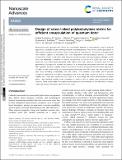Files in this item
Design of cross-linked polyisobutylene matrix for efficient encapsulation of quantum dots
Item metadata
| dc.contributor.author | Prudnikau, Anatol | |
| dc.contributor.author | Shiman, Dmitriy I. | |
| dc.contributor.author | Ksendzov, Evgenii | |
| dc.contributor.author | Harwell, Jonathon | |
| dc.contributor.author | Bolotina, Ekaterina A. | |
| dc.contributor.author | Nikishau, Pavel A. | |
| dc.contributor.author | Kostjuk, Sergei V. | |
| dc.contributor.author | Samuel, Ifor D. W. | |
| dc.contributor.author | Lesnyak, Vladimir | |
| dc.date.accessioned | 2021-03-02T11:30:44Z | |
| dc.date.available | 2021-03-02T11:30:44Z | |
| dc.date.issued | 2021-01-20 | |
| dc.identifier | 272793114 | |
| dc.identifier | b17edd32-de37-42ae-b846-269662c21037 | |
| dc.identifier | 85102248039 | |
| dc.identifier | 000629748000020 | |
| dc.identifier.citation | Prudnikau , A , Shiman , D I , Ksendzov , E , Harwell , J , Bolotina , E A , Nikishau , P A , Kostjuk , S V , Samuel , I D W & Lesnyak , V 2021 , ' Design of cross-linked polyisobutylene matrix for efficient encapsulation of quantum dots ' , Nanoscale Advances , vol. Advance Article . https://doi.org/10.1039/d0na01012j | en |
| dc.identifier.issn | 2516-0230 | |
| dc.identifier.other | Jisc: bc1c91b308ee4a37ab1551f7b85e8e66 | |
| dc.identifier.other | ORCID: /0000-0002-2508-1965/work/90952157 | |
| dc.identifier.uri | https://hdl.handle.net/10023/21537 | |
| dc.description | Funding: This work was supported by the EU Horizon 2020 Project MiLEDi (779373) and by the Belarusian Republican Foundation for Fundamental Research (grant X21MC-007). D. I. Shiman, E. Ksendzov, E. A. Bolotina, and S. V. Kostjuk acknowledge the support by the Erasmus+ Traineeship Programme for Higher Education. | en |
| dc.description.abstract | Photoluminescent quantum dots (QDs) are a prominent example of nanomaterials used in practical applications, especially in light-emitting and light-converting devices. Most of the current applications of QDs require formation of thin films or their incorporation in solid matrices. The choice of an appropriate host material capable of preventing QDs from degradation and developing a process of uniform incorporation of QDs in the matrix have become essential scientific and technological challenges. In this work, we developed a method of uniform incorporation of Cu–Zn–In–S (CZIS) QDs into a highly protective cross-linked polyisobutylene (PIB) matrix with high chemical resistance and low gas permeability. Our approach involves the synthesis of a methacrylate-terminated three-arm star-shaped PIB oligomeric precursor capable of quick formation of a robust 3D polymer network upon exposure to UV-light, as well as the design of a special ligand introducing short PIB chains onto the surface of the QDs, thus providing compatibility with the matrix. The obtained cross-linked QDs-in-polymer composites underwent a complex photostability test in air and under vacuum as well as a chemical stability test. These tests found that CZIS QDs in a cross-linked PIB matrix demonstrated excellent photo- and chemical stability when compared to identical QDs in widely used polyacrylate-based matrices. These results make the composites developed excellent materials for the fabrication of robust, stable and durable transparent light conversion layers. | |
| dc.format.extent | 12 | |
| dc.format.extent | 1258965 | |
| dc.language.iso | eng | |
| dc.relation.ispartof | Nanoscale Advances | en |
| dc.subject | QD Chemistry | en |
| dc.subject | QC Physics | en |
| dc.subject | NDAS | en |
| dc.subject.lcc | QD | en |
| dc.subject.lcc | QC | en |
| dc.title | Design of cross-linked polyisobutylene matrix for efficient encapsulation of quantum dots | en |
| dc.type | Journal article | en |
| dc.contributor.sponsor | European Commission | en |
| dc.contributor.institution | University of St Andrews. Organic Semiconductor Centre | en |
| dc.contributor.institution | University of St Andrews. School of Physics and Astronomy | en |
| dc.contributor.institution | University of St Andrews. Centre for Biophotonics | en |
| dc.contributor.institution | University of St Andrews. Condensed Matter Physics | en |
| dc.identifier.doi | https://doi.org/10.1039/d0na01012j | |
| dc.description.status | Peer reviewed | en |
| dc.identifier.grantnumber | 779373 | en |
This item appears in the following Collection(s)
Items in the St Andrews Research Repository are protected by copyright, with all rights reserved, unless otherwise indicated.

